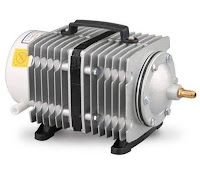What are the accessories for air pump?
Just an air pump won't be of any use to you. For that you'll need other attachments like air pipes, air stones, controllers, non-return check valves,etc. We will be talking about them in my own words, hopefully you'll find it useful.
Please note: This post contains Amazon Affiliate links. It would be highly appreciated if you please consider buying from the links provided. It won't cost you anything extra, but it may help us with a little bit of commission from Amazon.
• Air pipes
The only duty of an air pump is to pump air from the atmosphere through its nozzle, air pipes are then used to "transport" the air from the aforementioned nozzle to the tank. That air is then released underwater through air stones, but that's another story we'll talk about later.
The pipes used for aeration in fish tanks usually have an inner diameter of 4 mm (0.16 inch) and are made of plastic,silicone, etc. Both have their own pros and cons. Plastic pipes are cheaper but they become hard and loose their flexibility and gets damaged because of kinking. Silicone pipes are comparatively a bit costlier, but they are soft, flexible and they resist wear and tear way better than plastic pipes.
I've noticed that using silicone pipes are better because the ends don't get loose after repeated insertion of the nozzle of the air stones or air controllers, and that is very helpful because a loose end will cause the nozzle of the air stone to slip out and trust me, it is very very hard to find the fallen air stone in a tank full of water with fishes and floc in it. So, if you take my advice, go with silicone pipes, you will not regret. Maybe it will cost you a little extra but will save you from all the troubles we had to go through because of our bad decisions.
Please note: This post contains Amazon Affiliate links. It would be highly appreciated if you please consider buying from the links provided. It won't cost you anything extra, but it may help us with a little bit of commission from Amazon.
• Air stones
Air stones, also called "air-bubblers" are important fish tank accessories. Their nozzles slide into the cavity of the air pipes and the air from the pump is released through their pores in the form of bubbles. Air stones do not directly mix oxygen into the water. What they do is cause agitation on the surface of the water, allowing greater volume of water to release the built-up carbon dioxide and take in more oxygen.
There is a myriad collection of air stones in the market today. Try to go for cylindrical air stones with brass nozzles. The brass nozzle is longer lasting and has ridges that prevents them from slipping out.
Please note: This post contains Amazon Affiliate links. It would be highly appreciated if you please consider buying from the links provided. It won't cost you anything extra, but it may help us with a little bit of commission from Amazon.
• Controllers & connectors
Controllers are plastic attachments used to control the volume of air passing through the specific pipe. We should always opt for the sturdier controllers that are available, although a bit costlier.
Connectors are plastic ornaments too with a specific purpose, to divide one air line to two or three secondary lines. I always buy about a dozen extra because I do not know how I always keep losing them.
































